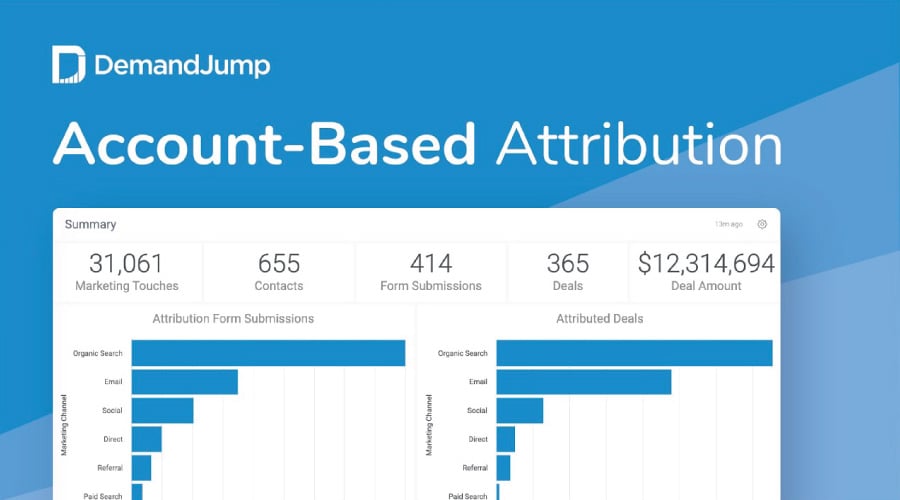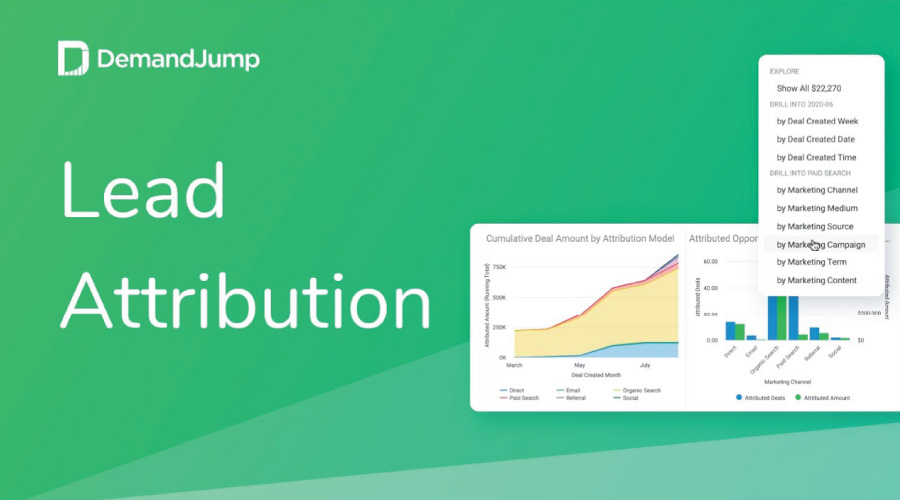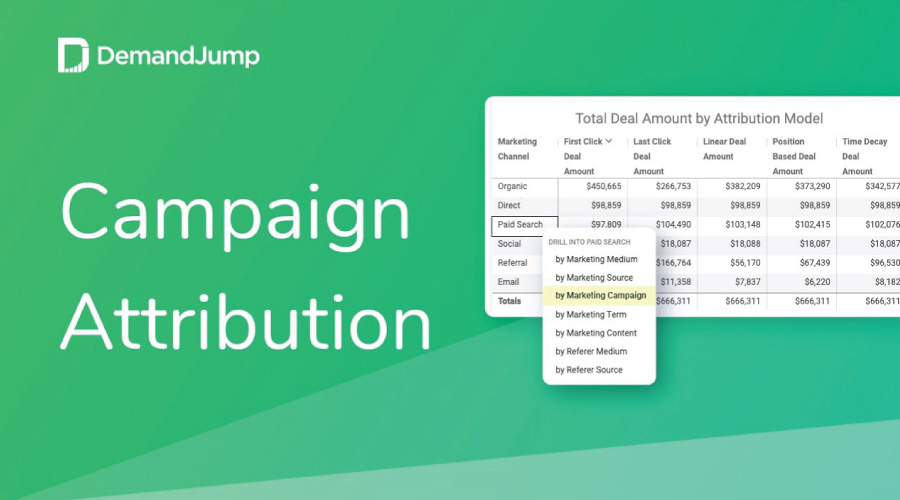Marketing Attribution
By embracing DemandJumps approach to SEO, we have been able to increase our organic rankings within just 2 weeks of implementing recommendations. This helped us see a 22% increase in organic search month-over-month.
Robert Jacko Vice President Digital Marketing @ Homage
DemandJump has become a crucial extension of our marketing team, providing game changing insights to fuel and propel all aspects of our digital marketing efforts. The DemandJump platform is a must have, we are seriously impressed.
Tim Lavinder Director of Ecommerce @ Hotsox
We used to spend hours looking for insights in dozens of tools and reports. Now we log into one place to find out what customers are doing and how to meet them where it matters most.
Zach Roop Digital Marketing Manager @ Dometic
We use DemandJump recommendations as our digital to-do list. We love going in and seeing the recommendations and knowing what to do next.
JoLynda Wilson Marketing Director @ IWC
Our Customers Love Attribution


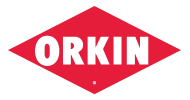



Account-Based Attribution
Eliminate wasted time and spend. With DemandJump's automated account-based attribution
solution you will know with certainty which efforts are driving ROI.
Measure Your Marketing Performance
Find out which of your marketing efforts are making the biggest impact. See which channel drove consumers to you, the pages they visited, and all touchpoints along their path to purchase.
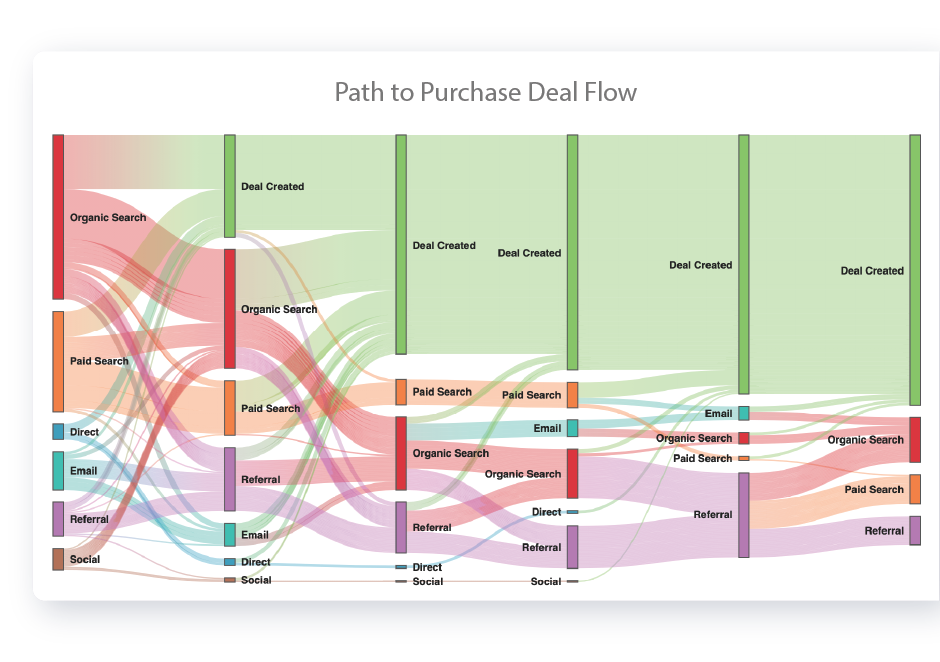
From Marketing Spend to Actual Pipeline Value
When a lead becomes a customer, you need to know which marketing channel or campaign should receive credit, and account-based attribution will give you the answers.
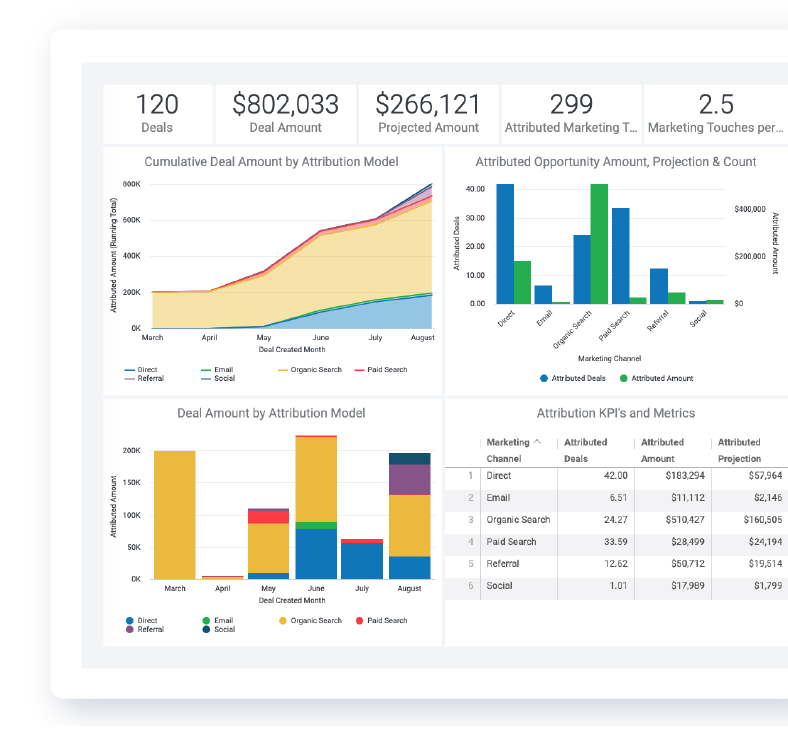
Organic & Paid Search Keyword Attribution
Beyond channel, campaign, and content attribution, you will finally see which organic and paid keywords are generating deal and opportunity revenue.
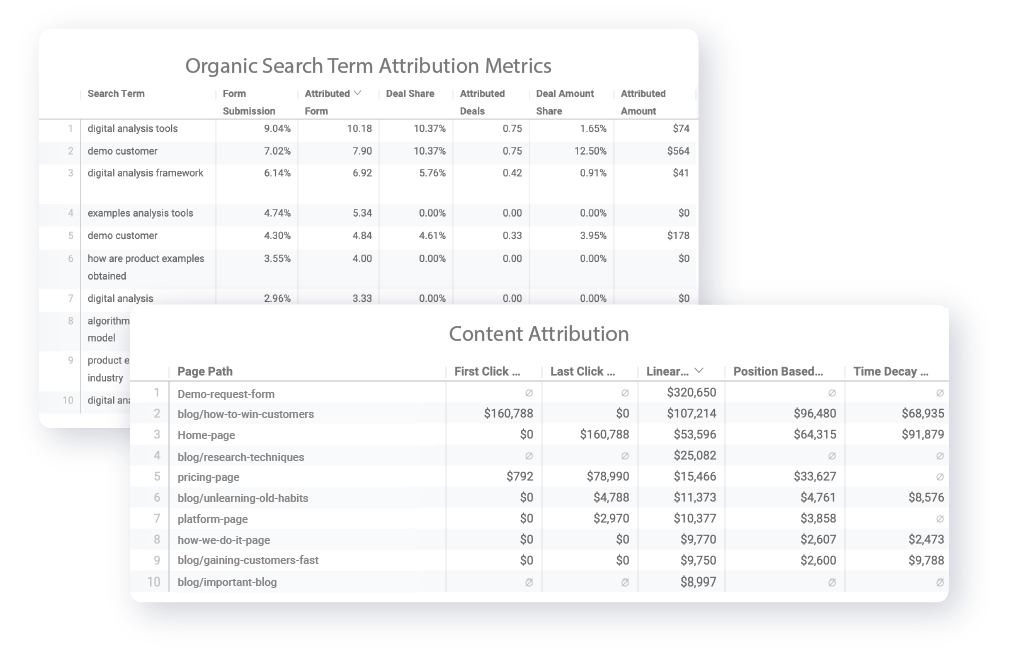
See a Demo of Attribution
Offline Attribution
A few years ago, the phrases omnichannel and multichannel were everywhere. This was the term used to describe marketing strategies that used many channels. Your channels might include social media platforms, email campaigns, paid ads, print ads, radio ads, television ads, and any online properties. As far as definitions go, this was pretty straight forward. Omnichannel approaches are still important. The difficulty many marketers have is in gathering all of the analytics across channels to properly assess how well campaigns are received in various areas.
Offline attribution is the way that you measure all of these metrics. It includes the data from your online marketing but it should also include touchpoints that are not online, such as customers in your physical location. Companies that ONLY market online are rare, though it may seem like that's the most common platform for communication at this point. The reality is that every time a client has contact with your company, it should be part of your data. Every customer service exchange, purchase, and especially the difficulties they encounter, are important to your branding. In fact, the experiences customers have with your company can offer more marketing power than any content marketing strategy that you employ.
The proof is in the pudding. As effective as your marketing campaigns might be, they need to be backed up with the same high standards and on-brand messaging in person. Your customers, past and present, represent one of your strongest marketing assets. They flex this power in online reviews, word of mouth, and their highly prized positive mentions on social media. This is advertising that you can't buy. Not really.
But these metrics are not easily captured in some of the most common data sets you use in your online content marketing. That doesn't mean that you're not capturing them at all. You likely have some of these metrics, or can build them, in your CRM. There are other tools you can use, too, to capture information about in-person transactions and social mentions. This helps you understand how your brand is perceived in a way that strictly analyzing your web traffic or social media analytics won't do.
Does Offline Marketing Still Work?
People so rarely discuss offline marketing that you might think it doesn't exist anymore. Offline marketing methods do still work. In fact, they sometimes work much better than more popular online methods.
Offline marketing should always be in most people's marketing plans in some form or fashion. We've overlooked it largely because online marketing, content marketing, social media marketing, and all of the other digital ways we reach our customers have taken center stage. In recent years, it may even seem like offline marketing examples were nonexistent. But that may be about to change in a big way.
The typical audience has become so saturated with content marketing and digital offerings that they've become adept at ignoring them. Email click-through rates are declining and, as much as you position your inbound marketing to offer value, the target audience has started to understand that the value propositions are another marketing technique. That doesn't mean that you should stop using these methods. They're still a good strategy. It just means that your target audience is not going to be easily swayed by those techniques unless they're already motivated to purchase.
Offline marketing may be poised to make a very marked comeback. It offers a more personalized face to your customer base. At this writing, the world is currently observing social distancing measures that make in-person marketing slightly more difficult, if not impossible. But it's a good bet that creative offline approaches will make big waves for ROI as we move back to more normal social constructs. By that point, people may well be tired of digital life. Offering them real experiences will garner a better reception.
A combination of both methods means that you'll need to develop online to offline measurement capabilities if you haven't already been using offline marketing attribution.
Some offline marketing examples that are still in use:
- Print Ads. This might include billboards and benches, but it also includes print magazines and newspapers. Depending on the market and location, this can be an affordable offline advertising option.
- Local Signage. If you have a brick and mortar location or do business in a set area, physical signage can be an excellent way to let the public know where to find you. This might include permanently installed signs at your business location and temporary banners at local events.
- Advertisements in Local Bulletins. Church bulletins were once a go-to method of local advertising. This still works. Whether you want to sponsor local sports teams or pay for advertising at charity and local chamber of commerce events.
- Radio Advertising. Radio advertising is not as popular as it once was but it is still a good method to keep your brand in the conversation.
- Television Advertising. Even with the popularity of streaming services, commercials are utilized by companies today.
- Point of Sale Ads. Flyers, coupons, and small giveaways near the register offer a great last impression for your customer.
- Press Releases. Getting in a local or national publication is an excellent way to get your company's name out in the public.
- Public Speaking. Guest or keynote speaking engagements offer a great way to cultivate business relationships and build B2B leads.
- Promotional Materials. It might sound played out, but promotional materials are still a great investment for your marketing budget. Putting your logo on a useful product, especially one that matches your branding, builds loyalty and name recognition. Even small things, like tee shirts with your name on them, can help with brand recognition.
Some of the best marketing campaigns are creative and unexpected. Don't be afraid to think outside to the box and jump on trends that offer a good opportunity for your business to shine.
Online to Offline Measurement
Online to offline measurement can be difficult to combine. Don't feel terrible if this aspect of the puzzle is confusing for you. Marketers everywhere have struggled with how to combine all of the possible data in a way that offers insights. Some marketers look at these analytics separately, but it's a better idea to be able to form a whole picture of all of your online and offline activity.
You also want to be able to measure your brand recognition. This is information that won't all come directly from your own analytics. You'll need to be creative in order to find all of the places where your brand is mentioned. There are ways that you can cultivate information directly from your customers, such as surveys. The biggest asset that you can find in your online to offline measurement efforts is a set of tools that allow you to effectively assess your reach across channels. For instance, you need to know whether the customers at your physical location decided to purchase because they heard an ad or visited your online website. It helps to see the percentage of sales that are directly related to signage to pull in foot traffic.
Online to Offline Examples
In the omnichannel approach, we realized that each contact point mattered. All content marketing should be directly connected to the brand and the experience should be the same for the customer. If they get a high level of service or have a preconceived notion of what your business is, they should get the same feeling from every contact point. There are some great tools that help you measure how well your efforts are performing overall.
Online to offline examples are plentiful. Using SMS advertising and mobile ads to catch customer's attention when they're in your vicinity or sending them a reminder to leave a review after they've been in or near your location. These are just some ways that you can link the digital and real-world contacts to your business.
Offline marketing also brings traffic to your website. This is important to note because statistics show that buyers need to interact with a brand several times before they decide to purchase.
How can you tell if someone came to your website after an offline contact? Here are some measurements you can look for:
Brand Name Search. One easy measurement to see is when they arrive at your site through a search using your own company name. This usually indicates that they've searched the name after hearing it or seeing it written somewhere else.
Use Distinct URLs. If you want to know how well a particular campaign is working, set a specific URL for that campaign only. This can work for in-person content you distribute, web addresses on signage, and links you've included somewhere online. If you want minute information, you can set different URLs for each channel so that you can easily see which channels are performing better for that campaign.
Use Specific Codes. Sales or discount codes are a great way to help you segment where your sales come from. Creating different codes for each channel gives you an accurate and easy to view assessment of which of your channels are working well for that offering.
What Is a KPI and Can It Measure Brand Awareness?
Key performance indicators (KPI) are possibly the most accurate way to measure brand awareness. Typically KPIs are a metric that shows how well the company is performing in a set area. You can set up analytics to measure any type of performance measurement or goal you're trying to attain. Some KPIs might be linked to overall sales, conversion rates, cost per lead, and traffic by channel. You can set key performance indicators to assess your offline branding ROI.
Offline marketing trends can add new layers to your marketing strategy but it's important for you to gather data that helps you assess how successful these techniques are. This is where setting KPIs can be advantageous. Judging brand awareness can seem like grabbing smoke. It is impossible to gather all of the information on what the public knows, thinks, or hears. Not every person will take an action that gives you this information. What you can do is concentrate your efforts on gathering the data that is available and trust that some of the unquantifiable brand recognition you've set in motion will eventually convert to data and, ideally, sales.
More and more, companies are realizing that finding ways to assess their current and past customer satisfaction is tied in with continued growth. Happy customers are your best brand ambassadors because they often refer you, and referrals are far more likely to convert than any other marketing initiative. Some ways that you can work toward pulling in this information is by offering surveys to customers, possibly with an incentive attached.
Social listening also provides great insights into how your customers feel about your brand, as do reviews. A good practice is to respond to all social mentions and reviews when possible, in a professional way that matches your branding. Be very careful that you don't reply to negative reviews in a hasty manner. Even if you think better of it later, the internet never forgets. Deleted comments have a way of coming back to haunt you in the form of a screenshot. The key in social media is that it allows your customers an in-person experience that feels natural. But you should always keep the best practices in mind when you respond.
What Is Offline Branding?
Offline branding includes all of the work you do to increase brand awareness, outside of your digital media and online marketing campaigns. Online branding does offer a lot of benefits. It's more cost-effective to use than some traditional marketing initiatives, such as billboards or television ads. You can also personalize your marketing initiatives online to a great degree by using various segmentation methods and software that helps you automate the process.
There are a few ways to use offline branding effectively to boost brand awareness in a big way. This can include an even more personalized touch, such as phone calls and personal emails and messages, rather than campaign email. This is a great, personalized way to make a connection with a lead.
Guerilla marketing tactics can be very effective when designed well. They are also traditionally less costly because they were always a creative way to compete with larger enterprises. For many companies, find humorous or eye-catching messaging can really help build brand awareness. Your audience will remember something that was clever or funny. When it's really well done, they'll be entertained enough to share it with their friends.
Print media metrics you might look for include the readership and circulation. Often print advertising metrics will vary depending on the specific audience and readership. There may even be different times of the year where the venue offers better ROI. Paid advertising in print media is still a good way to increase brand awareness and you can measure the print advertising KPI by using one of the techniques mentioned above, such as including discount codes in the ad.
The Offline Marketing Plan
It's recommended that you have a full marketing plan that includes all of your content and brand awareness initiatives. Your offline marketing plan would be a smaller topic within that plan and you should be looking at the ROI from this activity with your other marketing initiatives.
Your strategy might start with an assessment of offline marketing trends and a list of offline marketing activities. In fact, you might have several lists, activities that you currently use (along with the analytics for their performance), past activities, and future possible strategies.
The digital world is so widely used that it can almost feel as if offline marketing is no longer valid. That couldn't be further from the truth. Real-world connections carry a lot of weight, especially when the experience is positive. Your offline attribution models should help you understand how all of your initiatives, online and offline, work together and separately. Want to see how you're doing with attribution? Get a demo or free assessment from DemandJump today.
Marketing Attribution Resources
Marketing AttributionAttribution Tracking
B2B Marketing Attribution
Hubspot Attribution
Marketing Campaign Influence
Mobile Attribution
Multi Touch Attribution
Offline Attribution
Sales Forecasting
Sales Opportunity Attribution
The Future of Data-Driven Marketing
Opportunities of Internet Marketing
Other Resources
Channel Optimization
Consumer Behavior
Consumer Insights
Consumer Insights and Analytics
Competitor Analysis Tools
Content Marketing
Content Strategy
Cross-Channel Analytics
Customer Insight Research Techniques
Customer Journey Map
Market Intelligence
Marketing Analytics Techniques
Market Research
Marketing Attribution
Opportunities of Internet Marketing
Types of Consumer Insights



